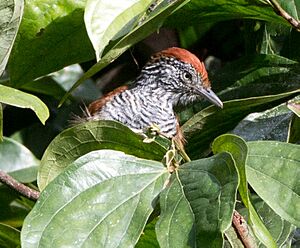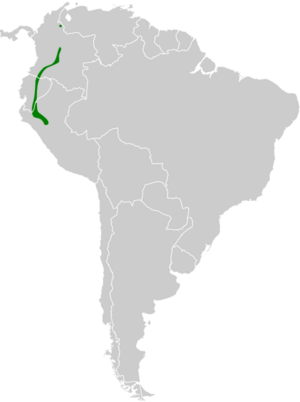Lined antshrike facts for kids
Quick facts for kids Lined antshrike |
|
|---|---|
 |
|
| Female, near Zamora, Ecuador | |
| Conservation status | |
| Scientific classification | |
| Genus: |
Thamnophilus
|
| Species: |
tenuepunctatus
|
 |
|
The lined antshrike (Thamnophilus tenuepunctatus) is a small bird that lives in the forests of South America. It belongs to a group of birds called "typical antbirds." You can find this bird in Colombia, Ecuador, and Peru.
Contents
About the Lined Antshrike
Scientists study birds to understand how they are related and how they fit into the animal kingdom. The lined antshrike was once thought to be a type of chestnut-backed antshrike. But in 2007, new research showed that the lined antshrike is its own unique species. It is a "sister species" to the chestnut-backed antshrike, meaning they are closely related.
There are three slightly different kinds, or subspecies, of the lined antshrike:
- T. t. tenuepunctatus
- T. t. tenuifasciatus
- T. t. berlepschi
What Does the Lined Antshrike Look Like?
The lined antshrike is about 15 to 16 centimeters (6 inches) long. It weighs around 22 to 23 grams (less than an ounce). These birds have strong bills with a hook at the end, much like a shrike's bill.
Male and female lined antshrikes look quite different, which is called sexual dimorphism. Both sexes have a crest of feathers on their heads.
- Males: Adult males of the main subspecies are mostly covered in narrow white and wider black stripes. Their head and crest are black. Their throat has black and white streaks.
- Females: Adult females have a reddish-brown (rufous) head, crest, upper body, wings, and tail. The back of their neck has a thin band of black and white or black and light reddish-brown. The sides of their head and throat are streaked black and white. The rest of their underside is barred with black and white, with a reddish-brown tint on their lower sides.
Both male and female adults have light-colored eyes that can vary in color. Young males look similar to adult males but have a yellowish-brown tint on their body and flight feathers. Males of the other two subspecies have black and white stripes that are about the same width. They also have more white on their foreheads than the main subspecies. Females of these subspecies are paler than the main one, with wider white stripes on their undersides.
Where the Lined Antshrike Lives
The lined antshrike lives along the eastern side of the Andes mountains. You can find it in Colombia, Ecuador, and Peru.
- The T. t. tenuepunctatus subspecies lives in north-central Colombia.
- The T. t. tenuifasciatus subspecies is found from south-central Colombia down through almost all of Ecuador.
- The T. t. berlepschi subspecies lives from southern Ecuador into northeastern Peru.
These birds mostly live at the edges of wet evergreen forests and secondary forests (forests that have grown back after being cut down). They like areas with lots of shrubs and thick plants close to the ground. They are usually found at elevations between 400 and 1,700 meters (about 1,300 to 5,600 feet) above sea level, depending on the country.
Lined Antshrike Behavior
Movement and Daily Life
The lined antshrike is thought to stay in the same area all year round. It does not migrate to different places.
What the Lined Antshrike Eats
The lined antshrike mainly eats insects and other small creatures like spiders, which are called arthropods. It usually looks for food alone or in pairs. It rarely joins large groups of different bird species that are feeding together.
It searches for food in thick plants, from close to the ground up to about 10 meters (33 feet) high. It hops from branch to branch, picking prey off leaves, stems, branches, and tree trunks with quick pecks.
Reproduction and Life Cycle
Scientists do not know much about when the lined antshrike breeds. Only one nest has ever been found with eggs, which was in Ecuador in late March.
This nest was shaped like a cup. It was made from small roots, leaf stems, and some fungus parts, with moss on the outside. It hung from a branch fork in a shrub about 2.2 meters (7 feet) above the ground. Another used nest, also in Ecuador, was built similarly and was about 1 meter (3 feet) above the ground. We still have much to learn about how these birds raise their young.
How the Lined Antshrike Communicates
The lined antshrike's song is a series of quick, nose-like notes. The song starts by getting higher in pitch, then falls towards the end. It finishes with a strong, rough note that goes downwards. People have described its song as "hah-ha-ha-hahahahahahahaha-hánh."
Conservation Status
The IUCN (International Union for Conservation of Nature) helps track how safe different animal species are. The lined antshrike is currently listed as a species of "Least Concern." This means it is not in immediate danger of disappearing.
It lives across a large area, and its population size is thought to be stable. One possible threat to this bird is deforestation, which is when forests are cut down for farming. However, the loss of trees is happening slowly, and the lined antshrike is not very sensitive to changes in its habitat. So, it is not thought to be badly affected right now. It is considered quite common in Colombia, Ecuador, and Peru.


